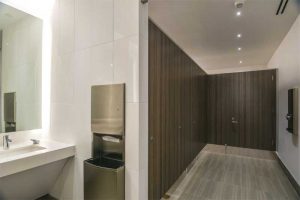Paper towel dispensers

Photo © Brett Drury
Paper towel dispensers are another common source of inefficiency. Many roll paper towel systems produce what is known as a ‘stub roll’ at the end of each roll. This stub roll comprises a portion of unused paper towels that is typically discarded. They also accumulate over time and contribute to unnecessary waste.
Dispensers without portion control features are also culprits, allowing patrons to dispense handfuls of towels at a time. Many units have adjustable pull lengths and portion control features to limit the amount of product dispensed per use. Some units also utilize shorter second pull lengths and delayed second activation to further discourage wasteful dispensing. Additionally, units equipped with stub roll utilization functionality can ensure every roll goes its furthest, providing complete consumable usage with less replacement time.
Similar to soap dispensers, many roll towel systems can permit open market purchasing freedom and cost savings by allowing facilities to utilize non-proprietary paper towels at a lower cost.
Deciding between roll and folded paper towel dispensers is another consequential specification decision that should be considered based on building occupancy. While roll paper towel dispensers tend to be the more sustainable option, many facilities prefer folded paper towels due to the elimination of stub roll waste. Also, employees often use folded paper towels at their workstations to remove makeup, grab door handles, and clean minor spills because they are more absorbent than roll towels.
Folded paper towel systems can also be equipped with paper towel-saving accessories to eliminate handful dispensing, ensuring only one towel is dispensed at a time. Folded towel dispensers also tend to be low profile, which can be appropriate when a minimalistic design aesthetic is desired, but recessed installation of a roll dispenser is unviable.
Hand dryers
Over the past several decades, hand dryers have become a popular option to complement or replace paper towel dispensers in some restrooms. They reduce waste as well as the need to manage an inventory of paper towels. In some buildings, hand dryers can result in cost savings compared to paper towel systems.
While hand dryers solve many sustainability challenges, other factors come into play. For example, wattage and functionality of hand dryers, and other accessories, can lead to high energy costs, reducing their impact.
In recent years, evolving consumer preferences have driven the demand for hand dryers with quicker dry times. Thus, high-speed hand dryers, also known as jet dryers, have increased in popularity. These models provide a faster hand-dry and hasten traffic flow in the restroom, improving efficiency.
However, many high-speed dryers run on high wattages and can lead to high energy bills, though recent innovations have yielded high-speed, energy-efficient designs. Moreover, newer technologies can have wattages as low as 200 kW and longer life expectancies, operating for as long as 7500 hours (or 10 years) in high-traffic environments, leading to reduced replacement cycles and further savings for the owner.
It should be noted the hand-drying solution should be appropriate for the needs of the building and its occupancy. For example, hand dryers may not be permitted in some facilities, in which case an efficient paper towel dispenser may help optimize operations. In other scenarios, both hand dryers and paper towels may be appropriate to provide the required flexibility.
Where hand dryers are used, it is essential to take a holistic approach to product selection. Before specifying a hand dryer, design professionals must consider the needs of the building occupancy in concert with product features like wattage, design, hygiene considerations, and noise levels.
Lighting
Lighting can be a significant contributor to high energy costs. In many commercial restrooms, the lights remain on at almost all times, regardless of the restroom being in use or not. This leads to high electrical costs, a fact compounded with the high cost of fluorescent or incandescent light bulbs. Fluorescent and incandescent lights are extremely inefficient by today’s standards, and 90 percent of the energy output from these light bulbs goes toward heat, while only 10 percent produces actual light. This is one reason why high-wattage bulbs, fixtures common among incandescent bulbs, are gradually becoming less readily available. Fluorescent lights are also known to spread light in all directions, leading to wasteful and significant energy draw.
In contrast, light-emitting diode (LED) lights use 75 percent less energy than incandescent lights, and the lower amount of heat produced could help substantially reduce HVAC running cost. Further, LEDs are directional in light emission, so they ‘throw’ light exactly where it is needed. LEDs can have up to 50,000 maintenance-free hours of useful life compared to a lifespan of around 10,000 hours for fluorescent lights (The useful life of a light-emitting diode (LED) light is defined as the time it takes for the light output to reach 70 percent of the initial output.). Finally, while fluorescent lights take time to get to full brightness, LEDs illuminate instantly.
The vanity is another opportunity to efficiently light the restroom. LED mirrors can support an elegant, modern aesthetic that enhances and simplifies vanity design while providing ample lighting at a low-energy cost.




